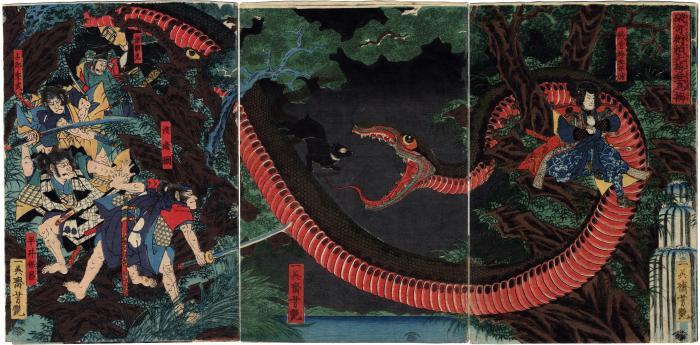Utagawa Yoshitsuya (歌川芳艶) (artist 1822 – 1866)
Yorimitsu tries to capture Hakamadare by destroying his magic (Kijutsu o yabutte Yorimitsu Hakamadare o karamen to su - 破奇術頼光袴垂為搦)
04/1858
29.025 in x 14.375 in (Overall dimensions;Overall dimensions) Japanese woodblock print
Signed: Ichieisai Yoshitsuya
一英斎芳艶
Publisher: Tsutaya Kichizō
(Marks 556 - seal 03-004)
Date seal: 4/1858
Museum of Fine Arts, Boston
The Agency for Cultural Affairs
Victoria and Albert Museum
Database of Folklore Illustrations
National Diet Library - go to #15
National Gallery of Victoria
University of Vienna
Hankyu Culture Foundation - right panel
Hankyu Culture Foundation - center panel
Hankyu Culture Foundation - left panel
Waseda University - left panel
Waseda University - middle panel
Waseda University - right panel
Museum of Oriental Art, Venice (via Ritsumeikan University) - the middle panel only
Museum of Oriental Art, Venice (via Ritsumeikan University) - the right-hand panel
Museum of Oriental Art, Venice (via Ritsumeikan University) - the left-hand panel
National Museum of Japanese History (via Ritsumeikan University) - center panel only
National Museum of Japanese History (via Ritsumeikan University) - left panel only
Nationaal Museum van Wereldculturen (Rijksmuseum Volkenkunde, Leiden) via Ritsumeikan University - right-hand panel only
Nationaal Museum van Wereldculturen (Rijksmuseum Volkenkunde, Leiden) via Ritsumeikan University - center panel only
Nationaal Museum van Wereldculturen (Rijksmuseum Volkenkunde, Leiden) via Ritsumeikan University - left-hand panel only
Lyon Collection - another copy of this triptych
The Pushkin Museum of Fine Arts
Hiroshige Museum of Art, Ena
Náprstek Museum
Syracuse University "This [triptych] is the most famous work of Yoshitsuya. Minamoto-no-Raikō and his retainers are alarmed at the sight of a ferocious fight between a huge snake and a giant bear manipulated by the thief Hakamadare's magical powers. This work, executed in 1858, is a satire on the political turmoil of that year."
Quoted from the English Supplement for Ukiyo-e Masterpieces in European Collectons 5: Victoria and Albert Museum II, #97, p. 6.
****
Illustrated in:
1) in color in 原色浮世絵大百科事典 (Genshoku Ukiyoe Daihyakka Jiten), vol. 4, pp. 118-119, #344.
2) in black and white in Chimi moryō no sekai : Ukiyoe : Edo no gekiga--reikai, makai no shujinkō-tachi (浮世絵魑魅魍魎の世界: 江戶の劇画 : 霊界魔界の主人公たち) by 中右瑛 (Nakau Ei), Ribun Shuppan, Tokyo, 1987, p. 56. [The text is entirely in Japanese.]
3) in Ukiyoe Museums in Japan (Nihon no ukiyoe bijutsukan - 日本の浮世絵美術館), vol. 3, pp. 150-151.
4) in color in Ukiyo-e Masterpieces in European Collection 5: Victoria and Albert Museum II, Kodansha, 1989, #97.
5) in color in Catalogue of Japanese Art in the Náprstek Museum published by The International Research Center for Japanese Studies: Nichibunken Japanese Studies Series 4, 1994, p. 173.
6) in black and white in The Male Journey in Japanese Prints by Roger Keyes, University of California Press, 1989, fig. 181, pp. 130-131.
7) in color in Japanese Yōkai and Other Supernatural Beings: Authentic Paintings and Prints of 100 Ghosts, Demons, Monsters and Magicians by Andreas Marks, Tuttle Publishing, 2023, pp. 30-31.
****
The University of Vienna writes of this triptych:
"In general, this print is said to caricature the shogunal succession dispute featuring the potential candidates Yoshinobu and Yoshitomi. The powerful magician Hakamadare personifies Tokugawa Nariaki, who is the leader of the Hitotsubashi party and daimyō of the Mito domain. The bewitched giant snake symbolizing Nariaki’s son Hitotsubashi Yoshinobu is chasing a little, black creature which is meant to be Tokugawa Yoshitomi, aged only twelve, who was the daimyō of the Kishū domain and part of the Nanki party as well as the 14th Shōgun Iemochi. Minamoto Yorimitsu (Raikō) represents tairō Ii Naosuke, who pushed the young Yoshitomi to becoming shōgun. The giant snake is not just depicted as a terrifying creature but at the same time it is powerful and gorgeous.
The proportions of the depicted figures and their correlation is confusing because the powerful Raikō (Ii Naosuke) is illustrated as a very small figure, despite the fact that he is winning the battle against Hakamadare (Nariaki, who lost the shogunal succession dispute). Probably, this print was issued just before or after Ii Naosuke became tairō on the 23rd day of the 4th month, when Ii’s handling of power and succession issues were still uncertain. In Yoshitsuya’s version of the power struggle, the Hitotsubashi party appears superior, but Yoshitsuya seems to sympathies with the Nanki party, who in the end won the struggle."
****
Other copies of the middle and right panels are from a group of 116 prints which were given by a private collector to the Real Academia Nacional de Farmacia in Spain. The same is true at the Manggha Centre of Japanese Art and Technology, Krakow.
****
There is another copy of this triptych at the Ōta Museum of Art. A copy of the center panel only is in the collection of the Museo de Arte Carrillo Gil.
Tsutaya Kichizō (蔦屋吉蔵) (publisher)
Yūrei-zu (幽霊図 - ghosts demons monsters and spirits) (genre)
warrior prints (musha-e - 武者絵) (genre)
magicians (mahōtsukai - 魔法使い) (genre)
Historical - Social - Ephemera (genre)
Minamoto no Yorimitsu or Raikō (源頼光: 948-1021) (role)
